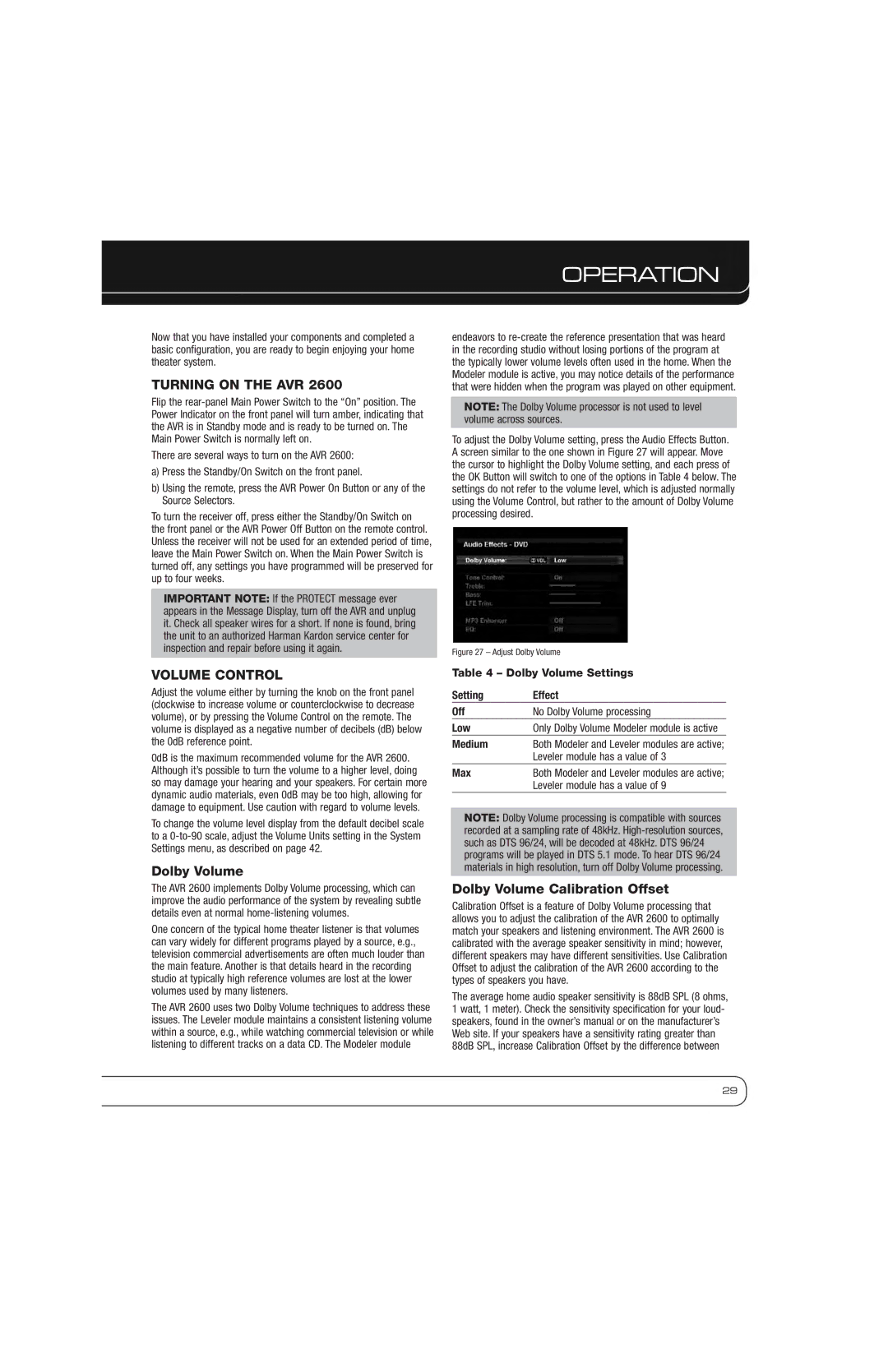Now that you have installed your components and completed a basic configuration, you are ready to begin enjoying your home theater system.
TURNING ON THE AVR 2600
Flip the rear-panel Main Power Switch to the “On” position. The Power Indicator on the front panel will turn amber, indicating that the AVR is in Standby mode and is ready to be turned on. The Main Power Switch is normally left on.
There are several ways to turn on the AVR 2600:
a)Press the Standby/On Switch on the front panel.
b)Using the remote, press the AVR Power On Button or any of the Source Selectors.
To turn the receiver off, press either the Standby/On Switch on the front panel or the AVR Power Off Button on the remote control. Unless the receiver will not be used for an extended period of time, leave the Main Power Switch on. When the Main Power Switch is turned off, any settings you have programmed will be preserved for up to four weeks.
IMPORTANT NOTE: If the PROTECT message ever appears in the Message Display, turn off the AVR and unplug it. Check all speaker wires for a short. If none is found, bring the unit to an authorized Harman Kardon service center for inspection and repair before using it again.
VOLUME CONTROL
Adjust the volume either by turning the knob on the front panel (clockwise to increase volume or counterclockwise to decrease volume), or by pressing the Volume Control on the remote. The volume is displayed as a negative number of decibels (dB) below the 0dB reference point.
0dB is the maximum recommended volume for the AVR 2600. Although it’s possible to turn the volume to a higher level, doing so may damage your hearing and your speakers. For certain more dynamic audio materials, even 0dB may be too high, allowing for damage to equipment. Use caution with regard to volume levels.
To change the volume level display from the default decibel scale to a 0-to-90 scale, adjust the Volume Units setting in the System Settings menu, as described on page 42.
Dolby Volume
The AVR 2600 implements Dolby Volume processing, which can improve the audio performance of the system by revealing subtle details even at normal home-listening volumes.
One concern of the typical home theater listener is that volumes can vary widely for different programs played by a source, e.g., television commercial advertisements are often much louder than the main feature. Another is that details heard in the recording studio at typically high reference volumes are lost at the lower volumes used by many listeners.
The AVR 2600 uses two Dolby Volume techniques to address these issues. The Leveler module maintains a consistent listening volume within a source, e.g., while watching commercial television or while listening to different tracks on a data CD. The Modeler module
endeavors to re-create the reference presentation that was heard in the recording studio without losing portions of the program at the typically lower volume levels often used in the home. When the Modeler module is active, you may notice details of the performance that were hidden when the program was played on other equipment.
NOTE: The Dolby Volume processor is not used to level volume across sources.
To adjust the Dolby Volume setting, press the Audio Effects Button. A screen similar to the one shown in Figure 27 will appear. Move the cursor to highlight the Dolby Volume setting, and each press of the OK Button will switch to one of the options in Table 4 below. The settings do not refer to the volume level, which is adjusted normally using the Volume Control, but rather to the amount of Dolby Volume processing desired.
Figure 27 – Adjust Dolby Volume
Table 4 – Dolby Volume Settings
Setting | Effect |
Off | No Dolby Volume processing |
Low | Only Dolby Volume Modeler module is active |
Medium | Both Modeler and Leveler modules are active; |
| Leveler module has a value of 3 |
Max | Both Modeler and Leveler modules are active; |
| Leveler module has a value of 9 |
NOTE: Dolby Volume processing is compatible with sources recorded at a sampling rate of 48kHz. High-resolution sources, such as DTS 96/24, will be decoded at 48kHz. DTS 96/24 programs will be played in DTS 5.1 mode. To hear DTS 96/24 materials in high resolution, turn off Dolby Volume processing.
Dolby Volume Calibration Offset
Calibration Offset is a feature of Dolby Volume processing that allows you to adjust the calibration of the AVR 2600 to optimally match your speakers and listening environment. The AVR 2600 is calibrated with the average speaker sensitivity in mind; however, different speakers may have different sensitivities. Use Calibration Offset to adjust the calibration of the AVR 2600 according to the types of speakers you have.
The average home audio speaker sensitivity is 88dB SPL (8 ohms, 1 watt, 1 meter). Check the sensitivity specification for your loud- speakers, found in the owner’s manual or on the manufacturer’s Web site. If your speakers have a sensitivity rating greater than 88dB SPL, increase Calibration Offset by the difference between

